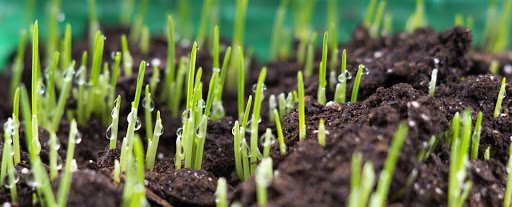How Long Does Grass Seed Take to Grow?
Growing grass from seed is the best way to get the lush, green lawn of your dreams. Having a carefully calibrated plan for starting your lawn is vital for long-term success. How long does grass seed take to grow? When should you plant? What grass seed variety should you use? These are a few of the key questions we will explore and things our local lawn seeding experts deal with frequently.
For this guide, we’ll be looking at the most common types of grass seed for the Midwest region: Kentucky bluegrass and tall fescue. These seed types are best suited to the varied climates of Midwest states and are ideally planted in the early fall. Now that we know our seed type and when to plant, let’s answer our final question, how long does it take for grass to grow, and further, how much time will you have to stay dedicated to your watering schedule? The short answer is six to nine weeks. For the longer answer, let’s first learn the process of growing grass seed.
The Process of Grass Seed Germination
Grass seed is naturally dry with less than 10% of its weight holding water. For the seed to germinate properly, it must absorb water through a process called imbibition. During this stage, the seed must have a constant source of moisture to ensure it is properly absorbing the nutrients necessary to grow. Careful attention to a watering schedule is critical to allow the seeds to germinate properly. The soil should remain consistently damp until the grass seed has sprouted.

The temperature of the soil and soil composition can all affect the length of time a seed takes to germinate.
When Is the Best Time Of Year To Plant Grass Seed?
The best time of the year to plant grass seed is usually in the early fall, around the beginning of September. Fall offers cooler temperatures which reduce the rate at which soil dries out, giving your seed more time to absorb moisture. Seeding in the fall gives your lawn a chance to grow and mature the entire fall season and the spring before the hot temperatures and droughts of the summer arrive. Another benefit to seeding in the fall is soil temperature. Fall offers warmer soil temperatures than the spring which allows seeds to germinate quicker with moisture.
The more consistent rains of early autumn also help maintain a good level of soil moisture. The combination of cooler temperatures and rains make this the best time of the year for putting down grass seed.
What Factors Impact Grass Growth?
As mentioned before, there are a number of factors that drastically affect the healthy growth of your seed. Firstly, the temperature of your soil is critical. Planting your grass seed in the early spring or late autumn leaves the seed vulnerable to temperature fluctuations and frosts. Kentucky bluegrass and tall fescue are generally resilient, but if the temperature dips too low before it has the chance to significantly mature, your grass could perish.
The same is true for higher temperatures. Tall fescue, for example, needs optimal soil temperatures close to 60 to 65 degrees Fahrenheit. Germination will begin at 50 degrees but warmer soil will encourage better growth in your seed. Too far above that temperature and you risk your soil drying out and the grass seed unable to take root and survive.
How Do You Put Down Grass Seed?
Step one is to scalp the existing turf and remove it from the area you want to plant. Ensure the area is clear before you begin working to spread your grass seed. Water the ground prior to putting down the seed.

Put half of your seed in the spreader and walk in straight lines in one direction across your yard. Fill the spreader with the rest of the seed and go back through your yard in perpendicular lines to your first pass.
This next step is the most important, your seed to soil contact. Your grass seed needs to be worked into the soil via some form of mechanical action. That can be through aerating, verticutting, or working the soil. The seed needs to be worked into the top half-inch of the soil to protect it from being washed away or drying out.
How Long After Planting Grass Seed Can You Walk On It?
Young grass seed is fragile so avoid walking on it for the first few weeks. Wait for your grass to grow to the proper height range, around 3.5-4 inches for Tall Fescue and 3 inches for Kentucky Bluegrass, before mowing it for the first time. Reduce the amount of water you are using prior to mowing so you do not damage your lawn and create ruts.
How Long After Planting Grass Seed Can You Mow?
With varying germination times depending on your grass seed type, wait until the blades are about three to four inches long before your first cut. Remember to stop watering roughly 48hrs prior to mowing so you don’t damage the seedlings and leave ruts in your lawn.
Your first time mowing once the grass has reached the proper height should only take about an inch off the top. This should leave the grass blades at two to three inches tall.
Our Conclusion On Getting Your Grass Seed To Grow Fully
How long does grass seed take to grow? Now that you are an expert in the germination process, you know six to nine weeks of consistent care will lead to a full, lush lawn. From initial seed spreading to full growth, the sight of a happy and healthy yard is a homeowner’s dream.
Grass Seeding Service By The Professionals
Ryan Lawn & Tree proudly serves Kansas City, Omaha, St. Louis, Tulsa, Wichita, Springfield, MO and Branson, MO.
We would love to help you with your grass seeding needs. Contact us today and get your Free Estimate for help with lawn seeding services by a RYAN lawn seeding pro!










